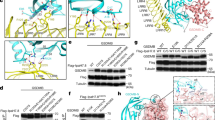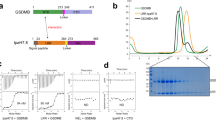Abstract
The Escherichia coli type III effector Map belongs to a large family of bacterial virulence factors that activate host Rho GTPase signaling pathways through an unknown molecular mechanism. Here we report direct evidence that Map functions as a potent and selective guanine-nucleotide exchange factor (GEF) for Cdc42. The 2.3-Å structure of the Map–Cdc42 complex revealed that Map mimics the GEF strategy of the mammalian Dbl family but has a three-dimensional architecture that is nearly identical to the bacterial GEF Salmonella spp. SopE. A comparative analysis between human and bacterial GEFs revealed a previously uncharacterized pairing mechanism between Map and the variable β2-3 interswitch region of Cdc42. We propose a GTPase selection model that is experimentally validated by the preferential activation Rac1 and RhoA by the Shigella spp. effectors IpgB1 and IpgB2, respectively. These results significantly expand the repertoire of bacterial GEF mimics and unify a GEF selection mechanism for host GTPase substrates.
This is a preview of subscription content, access via your institution
Access options
Subscribe to this journal
Receive 12 print issues and online access
$189.00 per year
only $15.75 per issue
Buy this article
- Purchase on Springer Link
- Instant access to full article PDF
Prices may be subject to local taxes which are calculated during checkout






Similar content being viewed by others
References
Burridge, K. & Wennerberg, K. Rho and Rac take center stage. Cell 116, 167–179 (2004).
Jaffe, A.B. & Hall, A. Rho GTPases: biochemistry and biology. Annu. Rev. Cell Dev. Biol. 21, 247–269 (2005).
Rossman, K.L. & Sondek, J. Larger than Dbl: new structural insights into RhoA activation. Trends Biochem. Sci. 30, 163–165 (2005).
Vetter, I.R. & Wittinghofer, A. The guanine nucleotide-binding switch in three dimensions. Science 294, 1299–1304 (2001).
Hart, M.J., Eva, A., Evans, T., Aaronson, S.A. & Cerione, R.A. Catalysis of guanine nucleotide exchange on the CDC42Hs protein by the dbl oncogene product. Nature 354, 311–314 (1991).
Eva, A. & Aaronson, S.A. Isolation of a new human oncogene from a diffuse B-cell lymphoma. Nature 316, 273–275 (1985).
Karnoub, A.E. et al. Molecular basis for Rac1 recognition by guanine nucleotide exchange factors. Nat. Struct. Biol. 8, 1037–1041 (2001).
Snyder, J.T. et al. Structural basis for the selective activation of Rho GTPases by Dbl exchange factors. Nat. Struct. Biol. 9, 468–475 (2002).
Nagai, H., Kagan, J.C., Zhu, X., Kahn, R.A. & Roy, C.R. A bacterial guanine nucleotide exchange factor activates ARF on Legionella phagosomes. Science 295, 679–682 (2002).
Amor, J.C. et al. The structure of RalF, an ADP-ribosylation factor guanine nucleotide exchange factor from Legionella pneumophila, reveals the presence of a cap over the active site. J. Biol. Chem. 280, 1392–1400 (2005).
Hardt, W.D., Chen, L.M., Schuebel, K.E., Bustelo, X.R. & Galan, J.E. S. typhimurium encodes an activator of Rho GTPases that induces membrane ruffling and nuclear responses in host cells. Cell 93, 815–826 (1998).
Buchwald, G. et al. Structural basis for the reversible activation of a Rho protein by the bacterial toxin SopE. EMBO J. 21, 3286–3295 (2002).
Alto, N.M. et al. Identification of a bacterial type III effector family with G protein mimicry functions. Cell 124, 133–145 (2006).
Kenny, B. et al. Co-ordinate regulation of distinct host cell signalling pathways by multifunctional enteropathogenic Escherichia coli effector molecules. Mol. Microbiol. 44, 1095–1107 (2002).
Ohya, K., Handa, Y., Ogawa, M., Suzuki, M. & Sasakawa, C. IpgB1 is a novel Shigella effector protein involved in bacterial invasion of host cells: its activity to promote membrane ruffling via Rac1 and Cdc42 activation. J. Biol. Chem. 280, 24022–24034 (2005).
Ohlson, M.B. et al. Structure and function of Salmonella SifA indicate that its interactions with SKIP, SseJ, and RhoA family GTPases induce endosomal tubulation. Cell Host Microbe 4, 434–446 (2008).
Handa, Y. et al. Shigella IpgB1 promotes bacterial entry through the ELMO-Dock180 machinery. Nat. Cell Biol. 9, 121–128 (2007).
Derewenda, U. et al. The crystal structure of RhoA in complex with the DH/PH fragment of PDZRhoGEF, an activator of the Ca2+ sensitization pathway in smooth muscle. Structure 12, 1955–1965 (2004).
Rossman, K.L. et al. A crystallographic view of interactions between Dbs and Cdc42: PH domain-assisted guanine nucleotide exchange. EMBO J. 21, 1315–1326 (2002).
Worthylake, D.K., Rossman, K.L. & Sondek, J. Crystal structure of Rac1 in complex with the guanine nucleotide exchange region of Tiam1. Nature 408, 682–688 (2000).
Aghazadeh, B. et al. Structure and mutagenesis of the Dbl homology domain. Nat. Struct. Biol. 5, 1098–1107 (1998).
Simpson, N. et al. The enteropathogenic Escherichia coli type III secretion system effector Map binds EBP50/NHERF1: implication for cell signalling and diarrhoea. Mol. Microbiol. 60, 349–363 (2006).
Arbeloa, A. et al. Subversion of actin dynamics by EspM effectors of attaching and effacing bacterial pathogens. Cell. Microbiol. 10, 1429–1441 (2008).
Hachani, A. et al. IpgB1 and IpgB2, two homologous effectors secreted via the Mxi-Spa type III secretion apparatus, cooperate to mediate polarized cell invasion and inflammatory potential of Shigella flexenri. Microbes Infect. 10, 260–268 (2008).
Beuzón, C.R. et al. Salmonella maintains the integrity of its intracellular vacuole through the action of SifA. EMBO J. 19, 3235–3249 (2000).
Boucrot, E., Henry, T., Borg, J.P., Gorvel, J.P. & Meresse, S. The intracellular fate of Salmonella depends on the recruitment of kinesin. Science 308, 1174–1178 (2005).
Brumell, J.H., Tang, P., Mills, S.D. & Finlay, B.B. Characterization of Salmonella-induced filaments (Sifs) reveals a delayed interaction between Salmonella-containing vacuoles and late endocytic compartments. Traffic 2, 643–653 (2001).
Stein, M.A., Leung, K.Y., Zwick, M., Garcia-del Portillo, F. & Finlay, B.B. Identification of a Salmonella virulence gene required for formation of filamentous structures containing lysosomal membrane glycoproteins within epithelial cells. Mol. Microbiol. 20, 151–164 (1996).
Berger, C.N., Crepin, V.F., Jepson, M.A., Arbeloa, A. & Frankel, G. The mechanisms used by enteropathogenic Escherichia coli to control filopodia dynamics. Cell. Microbiol. 11, 309–322 (2009).
García-Mata, R. & Burridge, K. Catching a GEF by its tail. Trends Cell Biol. 17, 36–43 (2007).
Self, A.J. & Hall, A. Purification of recombinant Rho/Rac/G25K from Escherichia coli. Methods Enzymol. 256, 3–10 (1995).
Zheng, Y., Hart, M.J. & Cerione, R.A. Guanine nucleotide exchange catalyzed by dbl oncogene product. Methods Enzymol. 256, 77–84 (1995).
Kenny, B. & Jepson, M. Targeting of an enteropathogenic Escherichia coli (EPEC) effector protein to host mitochondria. Cell. Microbiol. 2, 579–590 (2000).
Alto, N.M. et al. The type III effector EspF coordinates membrane trafficking by the spatiotemporal activation of two eukaryotic signaling pathways. J. Cell Biol. 178, 1265–1278 (2007).
Otwinowski, Z. & Minor, W. Processing of X-ray diffraction data collected in oscillation mode. Methods Enzymol. 276, 307–326 (1997).
Collaborative Computational Project, Number 4. The CCP4 suite: programs for protein crystallography. Acta Crystallogr. E 50, 760–763 (1994).
Terwilliger, T. SOLVE and RESOLVE: automated structure solution, density modification and model building. J. Synchrotron Radiat. 11, 49–52 (2004).
Jones, T.A., Zou, J.Y., Cowan, S.W. & Kjeldgaard, M. Improved methods for building protein models in electron density maps and the location of errors in these models. Acta Crystallogr. A 47, 110–119 (1991).
Brünger, A.T. et al. Crystallography & NMR system: a new software suite for macromolecular structure determination. Acta Crystallogr. D Biol. Crystallogr. 54, 905–921 (1998).
Acknowledgements
We would like to specifically thank J. Dixon (University of California, San Diego), M. Rosen and Kim Orth (University of Texas, Southwestern (UTSW)) for helpful discussion in preparation of this manuscript and for providing valuable reagents, and B. Kenny (Institute for Cell and Molecular Biosciences, Medical School, University of Newcastle) for wild-type EPEC2348/69 and EPECΔmap strains. S.E.S. and A.J.W. are supported by Texas ARP (grant 010019-0085-29007 to N.M.A.) and R.C.O is supported by the Welch foundation (grant I-1704 to N.M.A.). This work was supported by the Rita C. and William P. Clements Jr. endowment for scholars program (UTSW Medical Center) and by the Texas ARP grant 010019-0085-29007 to N.M.A., and by the Chinese Ministry of Science and Technology “863” grant no. 2008AA022305 and “973” grant no. 2006CB806704 to J.C.
Author information
Authors and Affiliations
Contributions
N.M.A., J.C., Z.H. and S.E.S. designed the research; Z.H., S.E.S., N.M.A. and J.C. performed the research; A.J.W., R.C.O., Z.W. and Y.F. provided new reagents and analytical tools and performed experiments; N.M.A. and J.C. wrote the paper.
Corresponding authors
Supplementary information
Supplementary Text and Figures
Supplementary Figures 1–4 and Supplementary Table 1 (PDF 1348 kb)
Rights and permissions
About this article
Cite this article
Huang, Z., Sutton, S., Wallenfang, A. et al. Structural insights into host GTPase isoform selection by a family of bacterial GEF mimics. Nat Struct Mol Biol 16, 853–860 (2009). https://doi.org/10.1038/nsmb.1647
Received:
Accepted:
Published:
Issue Date:
DOI: https://doi.org/10.1038/nsmb.1647
This article is cited by
-
Molecular mechanisms of Shigella effector proteins: a common pathogen among diarrheic pediatric population
Molecular and Cellular Pediatrics (2022)
-
ImitateDB: A database for domain and motif mimicry incorporating host and pathogen protein interactions
Amino Acids (2022)
-
Enteropathogenic E. coli effectors EspF and Map independently disrupt tight junctions through distinct mechanisms involving transcriptional and post-transcriptional regulation
Scientific Reports (2018)
-
Inhibition of protein interactions: co-crystalized protein–protein interfaces are nearly as good as holo proteins in rigid-body ligand docking
Journal of Computer-Aided Molecular Design (2018)
-
A systematic exploration of the interactions between bacterial effector proteins and host cell membranes
Nature Communications (2017)



